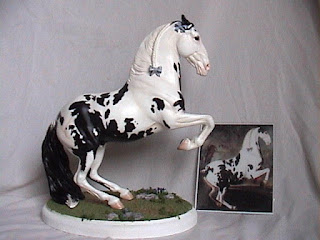This piece was originally intended for the 2007 auction, but I was unable to finish him in time. This is by far the most extensive custom I've ever created. He is basically an original sculpture over a whittled down resin armature. In 2008, he didn't meet his reserve at auction, so I did more work on his finish, adding subtle dapples and more warmth to his shading, which I think really helped to being this piece to completion. This was the last piece I offered as a donation to NAN. I realized that I just don't have the time to create a piece each year and give it the attention it deserves. The lack of photos showing his progress is evidence of how precious my time became throughout the process.Sayaad Al Assad
(Arabic for "The Lion Hunter")
This year’s portrait is inspired by the painting, “The Lion Hunt”, by Horace Vernet in 183
I will be using a Centeno resin by Gudrun Schmidt to customize into the grey Arab in the front. It will be a more involved overhaul than the previous portraits, as I will have to do a lot of refining and resculpting to turn the original resin into an Arab type.
His head has been whittled down considerably. Next step will be to soda glue the joints in place, attach his head with a thick wire to set his head and start sculpting. Additional dremeling will be needed to refine his legs, but I'll wait until he is standing and the new position is stabilized.
Next he was pinned back together and dremelled down to an armature. I dremeled down all four legs to realign joints and refine the cannons. Then I sculpted him into his present form.
Reserve Champion of Division, No Frills Live Show, Huntley, IL, Feb. 2009






























































